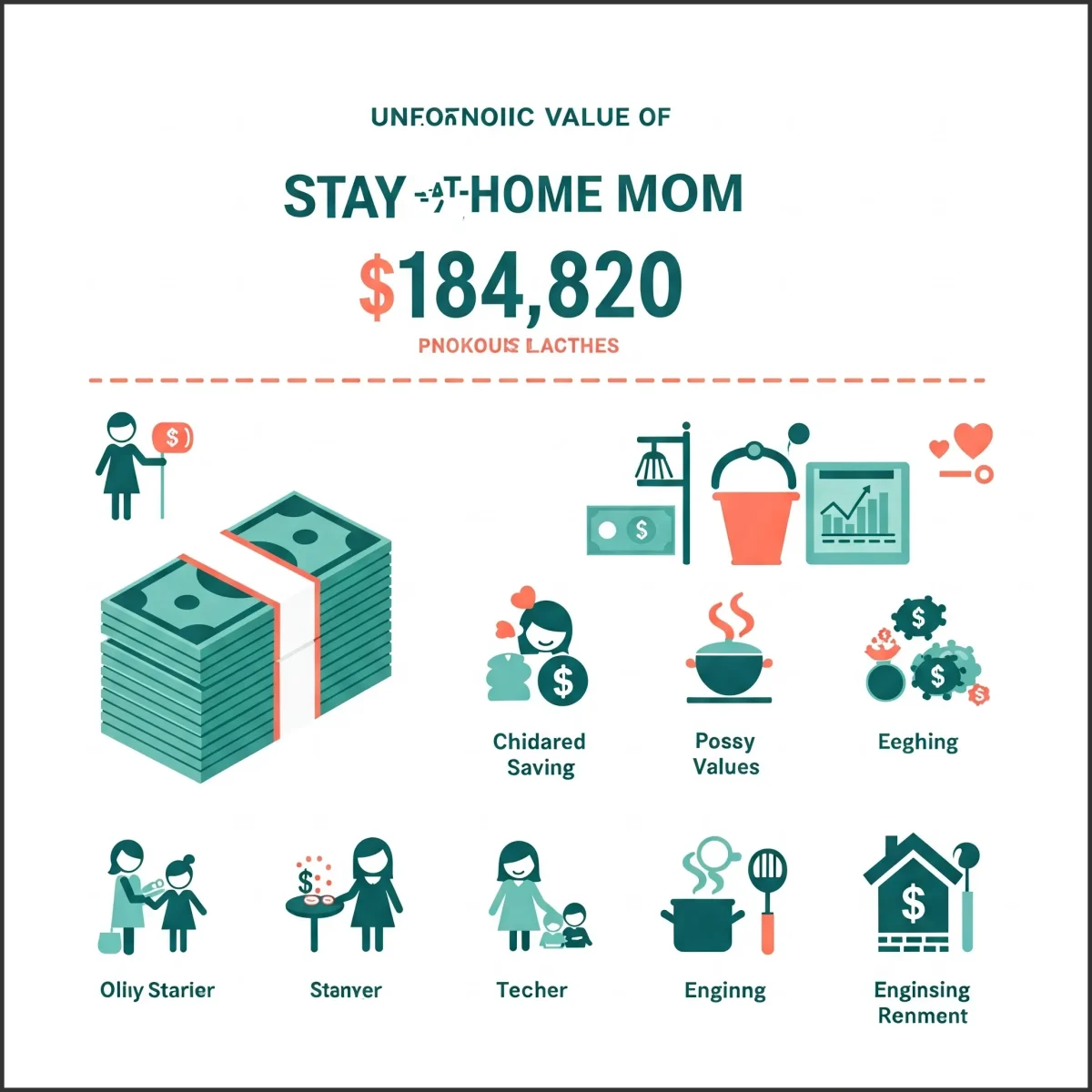
Choosing between being a stay-at-home mom (SAHM) or a working mom is literally one of the biggest decisions we face! As someone who’s spent countless hours researching this topic (and listening to my friends debate it endlessly), I’m breaking down everything you need to know about the economics of being a SAHM versus a working mom in 2025. Let’s dive into the real financial impacts and how this choice affects your household economics!
The Real Economic Value of Being a SAHM in 2025
Let’s be honest – society totally undervalues the work SAHMs do! But when you actually crunch the numbers, the economic contribution is HUGE.
According to the latest data from Salary.com, a stay-at-home parent’s work was valued at a whopping $184,820 in 2024 – that’s basically an executive-level salary! This calculation includes everything from childcare and cooking to cleaning, transportation, and the emotional labor that goes into running a household.
Other studies have estimated this value between $113,586 and $178,201 annually, depending on the methodology used. Either way, we’re talking six figures of unpaid labor!

The Hidden Economic Contributions
The economic value of a SAHM goes beyond just replacing paid services:
- Marginal economic benefit: Economists have calculated that the extra time SAHMs dedicate to childcare and household management (compared to working parents) provides approximately $19,655 in annual economic value.
- Global economic impact: Did you know that unpaid household work accounts for 40-50% of all labor in most economies? That’s TRILLIONS of dollars globally that never shows up in GDP calculations!
The crazy thing is that despite this massive economic contribution, SAHMs don’t receive formal recognition in economic frameworks. Like, hello? This is literally keeping our economy functioning!
Working Mom Economics: Breaking Down the Numbers
On the flip side, working moms bring their own unique financial picture to the table. If you’re trying to decide whether to keep your job or stay home with the kids, here’s what you need to consider:
Financial Advantages of Working Moms
- Higher household income: The most obvious benefit is bringing in a second income, which typically provides greater financial stability and opportunities for saving and investing.
- Long-term career growth: Staying in the workforce means continued professional development and higher lifetime earnings. Studies suggest that taking time away from your career for childcare could cost up to $1 million in potential earnings over your lifetime.
- Retirement benefits: Consistent contributions to retirement accounts and Social Security can significantly impact your financial security later in life.
Financial Challenges for Working Moms
Working mothers face unique financial hurdles that SAHMs don’t have to worry about:
- Childcare costs: This is the BIG one! In many urban areas, childcare can cost more than $2,000 per month per child, which can literally eat up an entire salary.
- Career sacrifices: Many working moms take positions with more flexibility but lower pay, which impacts long-term earning potential.
- Additional expenses: Don’t forget about commuting costs, professional wardrobe, convenience meals, and other work-related expenses that add up faster than you’d think!
If you’re struggling with tax planning for your family, check out our Tax-Smart Family Asset Transfers guide for some seriously helpful tips that could save you thousands!
How the Pandemic Changed Everything for SAHM and Working Mom Economics

The COVID-19 pandemic was literally a game-changer for women’s employment and the SAHM versus working mom debate.
The “She-cession” Effect
When schools and daycares closed during the pandemic, guess who picked up the slack? Women, especially mothers. The statistics are shocking:
- Over 3.5 million mothers with school-age children left the workforce or reduced hours during the pandemic
- Women’s labor force participation dropped to levels not seen since the 1980s
- Job recovery for mothers has lagged behind other demographic groups
This massive disruption created a whole new category of “involuntary SAHMs” – women who wanted to work but couldn’t due to caregiving responsibilities.
The Rise of Remote Work
If there’s ONE positive outcome from the pandemic for the SAHM and working mom dilemma, it’s the normalization of remote work! This flexibility has created new possibilities for balancing career and family:
- Hybrid work arrangements: Many companies now allow employees to split time between home and office, reducing commuting costs and increasing flexibility.
- Fully remote positions: Some moms have found that fully remote roles allow them to maintain careers while being more present at home.
- Side hustles and freelancing: The gig economy has provided new income streams that fit around family schedules.
Planning a getaway to reset from all this career decision stress? Our Ultimate Coachella Festival Guide 2025 has everything you need for an amazing experience!
SAHM vs. Working Mom: The Complete Financial Comparison
When making this massive life decision, it helps to break down the actual economics of both paths:
Total Household Economics: SAHM vs. Working Mom
| Category | SAHM Household | Working Mom Household |
|---|---|---|
| Income | Single income | Dual income |
| Childcare costs | Minimal/none | $12,000-30,000+ annually per child |
| Tax benefits | More likely to qualify for certain credits | Higher tax bracket, fewer deductions |
| Career trajectory | Potential gap in resume | Continued advancement |
| Time economics | More family time, less outsourcing | Less family time, more outsourcing |

Making the Right Decision for YOUR Family
Here’s the truth: there’s no one-size-fits-all answer to the SAHM and working mom question! The economics vary wildly based on:
- Your earning potential
- Local cost of living
- Number and ages of children
- Available support systems
- Career flexibility
- Personal values and priorities
The Search Trends Telling the Real Story
Google search trends for terms like “SAHM vs working mom financial impact” and “pandemic effect on women’s employment” have skyrocketed in recent years. This reflects the growing interest in understanding the economic implications of these choices.
More women are searching for concrete data to help make informed decisions rather than just emotional or cultural arguments. The most popular related searches include:
- “SAHM financial value calculator”
- “Working mom vs SAHM budget comparison”
- “Hidden costs of being a working mother”
- “Tax benefits for stay-at-home parents”

The Bottom Line on SAHM and Working Mom Economics
The decision between being a SAHM or a working mom involves complex financial trade-offs that go way beyond simple income calculations. Both roles provide tremendous value to families and society, even if that value isn’t always recognized in traditional economic terms.
What’s most important is finding the arrangement that works for YOUR family’s unique situation and values. And remember – this doesn’t have to be a permanent choice! Many women move between these roles at different stages of their lives and careers.
Whatever path you choose, knowing the real economic impact of your decision will help you plan more effectively and advocate for policies that support all mothers, regardless of employment status.
What has been your experience with the economics of being a SAHM or working mom? Drop a comment below – I’d love to hear your perspective!

